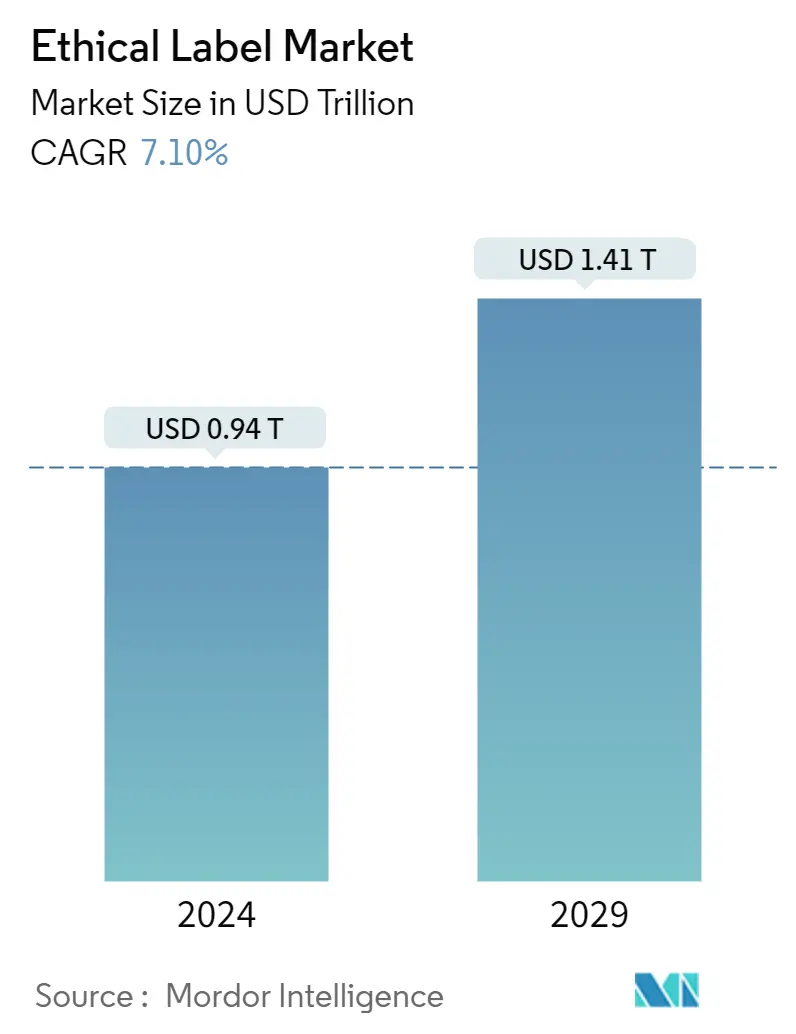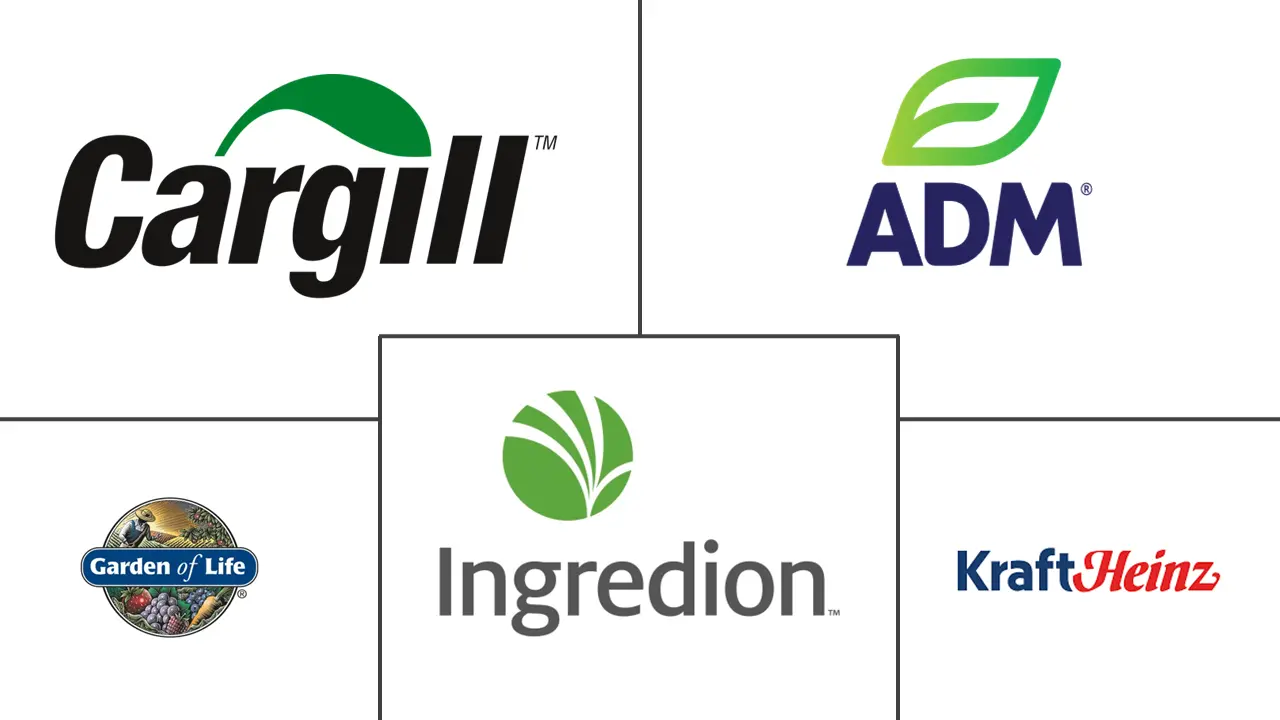Market Size of Ethical Label Industry

| Study Period | 2019 - 2029 |
| Market Size (2024) | USD 0.94 Trillion |
| Market Size (2029) | USD 1.41 Trillion |
| CAGR (2024 - 2029) | 7.10 % |
| Fastest Growing Market | Asia Pacific |
| Largest Market | North America |
| Market Concentration | High |
Major Players
*Disclaimer: Major Players sorted in no particular order |
Ethical Label Market Analysis
The Ethical Label Market size is estimated at USD 0.94 trillion in 2024, and is expected to reach USD 1.41 trillion by 2029, growing at a CAGR of 7.10% during the forecast period (2024-2029).
A high degree of awareness and concern regarding the right food consumption drives food and beverage companies toward transparency and adopting ethical labels for their products.
- The increased consumer interest in sustainable practices, fair trade, and ethical sourcing drives the ethical labels market. The market is expanding because consumers are increasingly interested in learning how individual food products affect the environment. The ethical labels market is driven by the acceptance of certain foods & beverages and the shift in consumers' consumption habits. The contribution of Jewish and Muslim consumers can be attributed to the rise of kosher and halal ethical-certified products.
- The advocacy of high ethical standards for manufacturing and consumption increasingly influences companies to opt for ethical labels, which promote environmental sustainability, animal well-being, social justice, equality, and adherence to a more promising workplace and worker qualities, thereby boosting the market.
- A sizeable population, especially millennials, has been influential in increasing awareness toward healthy and clean-certified products. This trend is increasing in the baby boomer population as well. There is a gradual shift among consumers toward more nutritious eating habits. According to the Global Organic Trade Guide, in 2022, the retail sales value of health and wellness (HW) packaged food and beverages in Japan amounted to around USD 56.3 billion. The sector was forecast to grow steadily and exceed USD 57.3 billion in 2025.
- However, ethical labels often require additional certifications and compliance measures, which can lead to increased costs for manufacturers and suppliers. These additional costs may be passed on to the consumers, making ethical products relatively more expensive compared to non-ethical alternatives.
- Another restraint for the studied market is the limited availability of products with ethical labels in some regions or markets. This can be due to various factors like limited production capacity, distribution challenges, or lack of demand in certain areas. Also, standardized regulations or guidelines for ethical labeling can create clarity and consistency in the market.
Ethical Label Industry Segmentation
Ethical labeling is not an unequivocal concept but may be defined differently depending on the context. In this report, ethical labeling means a product is labeled with information on whether the production process respects ethical values. The information may appear in the shape of text, a symbol on the product, or a combination of text and symbol. The report's scope is comprehensive and limited to food and beverage product types.
The ethical label market is segmented by label type (halal, organic, clean, sustainability and fairtrade labels, animal welfare labels, vegan labels, and other label types), by product type (food and beverages), by distribution channel (offline and online), and by geography (North America, Europe, Asia Pacific and Rest of the World). The market sizes and forecasts are provided in terms of value in USD for all the above segments.
| By Label Type | |
| Halal | |
| Organic | |
| Clean | |
| Sustainability and Fairtrade labels | |
| Animal Welfare Labels | |
| Vegan Labels | |
| Other Label Types |
| By Product Type | |
| Food | |
| Beverages |
| By Distribution Channel | |
| Offline | |
| Online |
| By Geography*** | |
| North America | |
| Europe | |
| Asia | |
| Australia and New Zealand | |
| Latin America | |
| Middle East and Africa |
Ethical Label Market Size Summary
The ethical labels market is experiencing significant growth, driven by increasing consumer awareness and demand for transparency in food and beverage products. This trend is largely fueled by a heightened interest in sustainable practices, fair trade, and ethical sourcing, as consumers become more conscious of the environmental impact of their food choices. The market is further bolstered by the growing acceptance of ethical-certified products, such as kosher and halal, particularly among Jewish and Muslim consumers. Companies are increasingly adopting ethical labels to align with high standards of environmental sustainability, animal welfare, and social justice, which in turn is promoting a shift towards more nutritious and clean-certified products. However, the market faces challenges such as the need for additional certifications, which can increase costs, and limited product availability in certain regions.
The beverage industry is poised to capture a substantial share of the ethical labels market, driven by a shift in consumer preferences towards non-alcoholic and plant-based alternatives. The rise of plant-based beverages and the demand for products with clean labels, such as gluten-free and non-GMO, are key factors contributing to market expansion. The Asia-Pacific region, with its growing disposable income and changing lifestyles, presents significant growth opportunities, particularly in the packaged beverage sector. The market is characterized by a few major players who compete on product quality and innovation. Recent developments include the introduction of clean-label ingredient solutions and enzyme technologies to meet consumer demands for ethical and sustainable products. These advancements are expected to further fuel the market's growth during the forecast period.
Ethical Label Market Size - Table of Contents
-
1. MARKET INSIGHTS
-
1.1 Market Overview
-
1.2 Industry Attractiveness - Porter's Five Forces Analysis
-
1.2.1 Bargaining Power of Suppliers
-
1.2.2 Bargaining Power of Consumers
-
1.2.3 Threat of New Entrants
-
1.2.4 Threat of Substitutes
-
1.2.5 Intensity of Competitive Rivalry
-
-
1.3 Industry Value Chain Analysis
-
1.4 Assessment of the Impact of COVID-19 on the Industry
-
-
2. MARKET SEGMENTATION
-
2.1 By Label Type
-
2.1.1 Halal
-
2.1.2 Organic
-
2.1.3 Clean
-
2.1.4 Sustainability and Fairtrade labels
-
2.1.5 Animal Welfare Labels
-
2.1.6 Vegan Labels
-
2.1.7 Other Label Types
-
-
2.2 By Product Type
-
2.2.1 Food
-
2.2.2 Beverages
-
-
2.3 By Distribution Channel
-
2.3.1 Offline
-
2.3.2 Online
-
-
2.4 By Geography***
-
2.4.1 North America
-
2.4.2 Europe
-
2.4.3 Asia
-
2.4.4 Australia and New Zealand
-
2.4.5 Latin America
-
2.4.6 Middle East and Africa
-
-
Ethical Label Market Size FAQs
How big is the Ethical Label Market?
The Ethical Label Market size is expected to reach USD 1.01 trillion in 2025 and grow at a CAGR of 7.10% to reach USD 1.42 trillion by 2030.
What is the current Ethical Label Market size?
In 2025, the Ethical Label Market size is expected to reach USD 1.01 trillion.

